To craft impactful internal presentations, use storytelling frameworks like the Classic Problem-Solution to clearly address challenges and solutions. Incorporate the Hero’s Journey to motivate your team, and organize content with the Three-Act Structure and Pyramid Principle for logical flow. Employ data-driven visuals and emotional arcs to connect on a deeper level, while success stories and visuals boost engagement. Exploring these strategies further can help you deliver memorable, persuasive messages that resonate with your audience.
Key Takeaways
- Use the Pyramid Principle to structure ideas hierarchically, ensuring clarity and logical flow for internal audiences.
- Apply the Before-After-Bridge model to highlight current challenges, desired outcomes, and solutions, motivating change.
- Incorporate data-driven storytelling with visualizations to support key points and enhance understanding.
- Leverage the Three-Act Framework to vary tone, deepen engagement, and maintain audience attention throughout the presentation.
- Utilize the STAR Technique to organize internal success stories, emphasizing actions and results for impactful communication.
The Classic Problem-Solution Structure

Have you ever struggled to clearly communicate a complex issue or persuade your audience to take action? The classic problem-solution structure simplifies this challenge by framing your message around a clear issue and its resolution. In today’s fast-paced environment, understanding industry trends helps you craft relevant problems that resonate with your audience. When you present the problem ethically, you build trust and credibility, ensuring your storytelling adheres to storytelling ethics. This structure guides your audience through a logical flow, making it easier for them to see the importance of your solution. By focusing on a compelling problem that aligns with current industry insights, you create a presentation that’s both engaging and persuasive, encouraging your audience to embrace your proposed solution. Recognizing how tuning modifications can influence outcomes ensures your story remains grounded in real-world applications.
The Hero’s Journey in Business Narratives
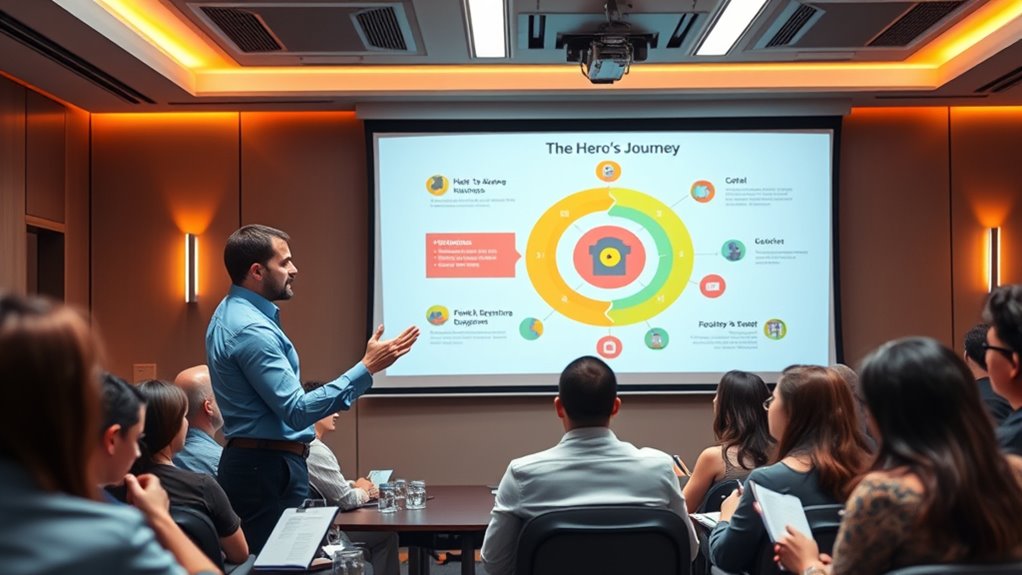
Ever wondered how storytelling arcs can transform a business presentation into a compelling journey? The Hero’s Journey taps into mythical archetypes and narrative symbolism to engage your audience. It follows a clear structure: the hero (your company or team) faces challenges, receives guidance, and emerges transformed. Using this framework, your story becomes relatable and memorable, inspiring action. Incorporate symbols like the mentor or the ordeal to deepen engagement. This archetypal pattern resonates universally, making complex ideas accessible. By framing your message as a hero’s quest, you create a narrative that motivates, aligns, and empowers your team. Understanding the importance of contrast ratio and color accuracy can help you craft visuals that support your story and captivate your audience.
The STAR Technique for Clear Communication

The STAR technique helps you structure your story clearly and effectively. By focusing on specific points—Situation, Task, Action, Result—you highlight key elements that keep your audience engaged. When used well, it guarantees your message is both compelling and easy to follow. Incorporating analytical thinking into your storytelling can further enhance your ability to assess and communicate your message convincingly.
Structuring Your Story
Are you looking for a straightforward way to organize your internal presentations? The STAR technique helps you structure your story clearly, avoiding common storytelling pitfalls. Think of it as a set of metaphor examples that guide your narrative—S for Situation, T for Task, A for Action, and R for Result. This framework keeps your message focused and easy to follow, making it easier for your audience to grasp your key points. By sticking to these elements, you prevent your story from becoming muddled or overly complicated. Remember, clarity is key. Using the STAR method ensures your presentation flows logically, engages your team, and highlights your message’s value. It’s a simple, effective approach for creating impactful, well-structured internal stories. Additionally, understanding your personality traits can enhance your communication style and help tailor your storytelling to resonate better with your audience.
Highlighting Key Elements
How can you guarantee your internal presentations convey your message clearly? Focus on highlighting key elements using the STAR technique—Situation, Task, Action, Result. This method helps you organize information logically, making your message clear and memorable. Incorporate metaphor usage to simplify complex ideas and create vivid mental images, enhancing understanding. Pay attention to storytelling pacing; avoid rushing through details or dragging out points, ensuring your audience stays engaged and absorbs vital insights. Emphasize the most impactful elements at the right moments, guiding your audience through your narrative smoothly. Additionally, understanding home improvement principles such as decluttering can help you create a more organized and effective presentation environment. By being intentional with these key elements, you make your presentation more compelling, ensuring your message resonates long after the slides are gone.
Ensuring Audience Engagement
Ever wondered how to keep your audience truly engaged during internal presentations? The key lies in encouraging audience participation and using visual aids effectively. Ask questions, invite feedback, or include quick polls to make your audience feel involved. Visual aids, like clear charts, images, or infographics, help illustrate your points and maintain interest. Keep your slides simple, avoiding clutter to guarantee your message stands out. Vary your tone and incorporate storytelling elements to make your presentation relatable. When your audience actively participates and can easily follow your visuals, their engagement naturally increases. Remember, a lively, interactive presentation leaves a lasting impression and makes complex information more digestible. Use the STAR technique to structure your message clearly, fostering connection and understanding. Additionally, incorporating visual aids can significantly enhance your message delivery and audience retention.
The Three-Act Framework for Engaging Stories
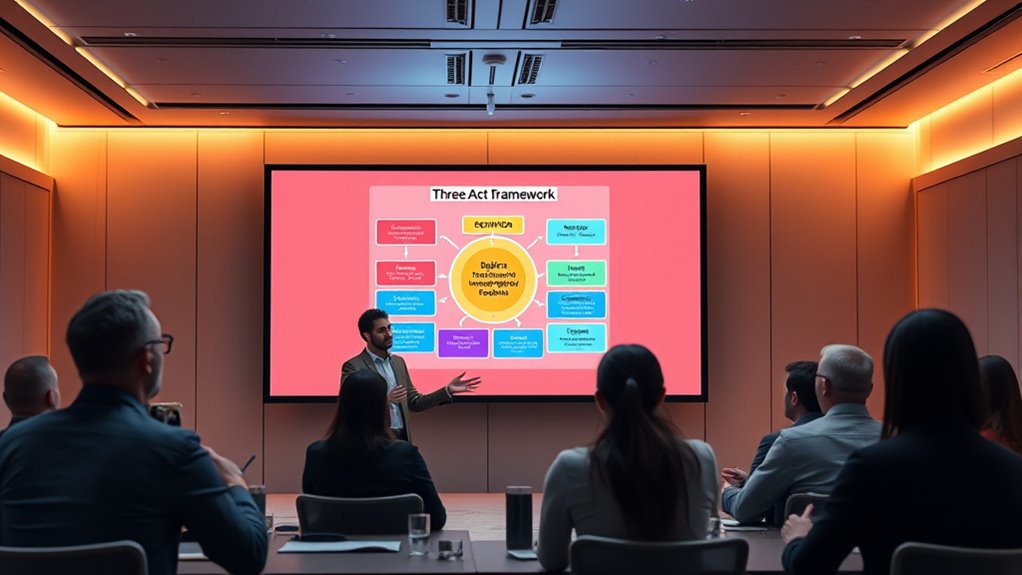
Have you ever wondered why some stories captivate audiences from start to finish? The Three-Act Framework makes your narrative compelling by structuring it into clear, impactful sections. Act One introduces the context and hooks your audience, while Act Two deepens the conflict or challenge. Act Three delivers resolution and closure. To enhance engagement, use metaphor analysis to create vivid imagery that resonates emotionally. Varying your tone throughout each act keeps your audience attentive—shifting from curiosity to tension, then relief. This tone variation guides emotional responses naturally, making your story memorable. Additionally, understanding personal development principles like goal setting and self-reflection can help craft stories that inspire and motivate your audience. Mastering the Three-Act Framework with strategic metaphor use and tone shifts transforms your internal presentations into engaging, persuasive stories that leave a lasting impression.
The Pyramid Principle for Logical Flow

Do you want your internal presentations to flow logically and persuade effectively? The Pyramid Principle helps you organize your ideas clearly, starting with the main message and supporting points. By using audience analysis, you can tailor your content to resonate with your listeners’ needs. Incorporate data visualization to clarify complex information and highlight key insights. This approach guarantees your points are structured logically, making it easier for your audience to follow and understand. When applying the Pyramid Principle, focus on clarity, grouping related ideas together, and presenting them in a hierarchical order. This method not only enhances the flow of your presentation but also boosts your credibility, making your message more compelling and memorable.
The Before-After-Bridge Model

How can you effectively guide your audience through change or new ideas? The Before-After-Bridge model is a powerful tool in corporate storytelling that enhances presentation dynamics. It starts by highlighting the “Before” state, making your audience recognize the current challenges. Then, you paint the “After,” illustrating the desired future or solution. Finally, you use the “Bridge” to connect these two points, explaining how your proposal or idea will lead to that better future. This structure creates a compelling narrative that makes complex concepts relatable and motivates action. It simplifies the journey from problem to solution, keeping your audience engaged and focused. Additionally, understanding the use of cookies and user consent can help tailor your messaging for better engagement with your audience privacy and cookies. By implementing the Before-After-Bridge model, you craft clear, impactful internal presentations that resonate and inspire change.
The Data-Driven Storytelling Approach
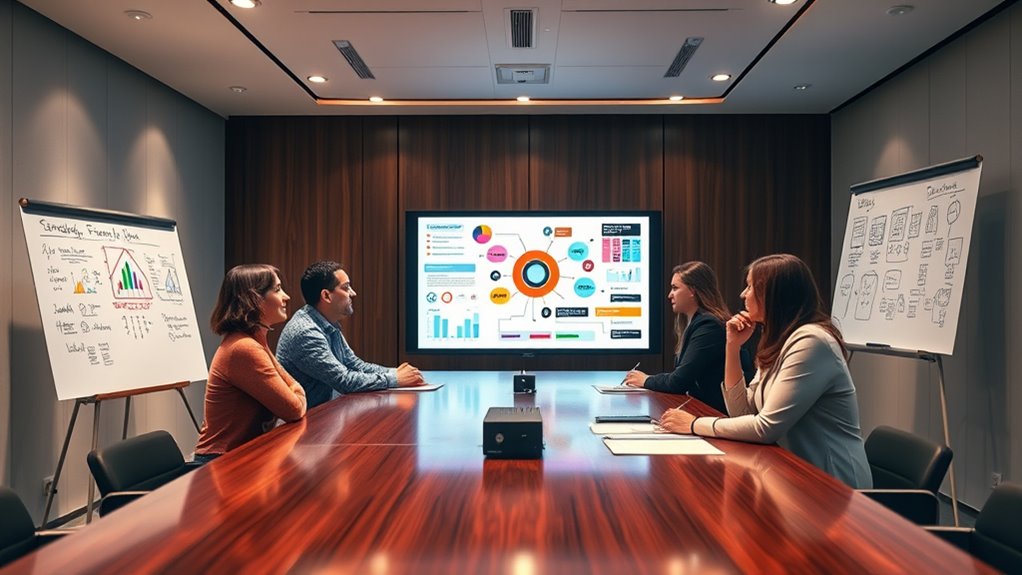
When you want to persuade your audience with compelling evidence, the Data-Driven Storytelling Approach becomes a powerful tool. It centers on using data visualization and storytelling metrics to clarify complex information. Here’s how to implement it effectively:
- Identify key data points that support your message.
- Use clear, engaging data visualizations to highlight trends and insights.
- Track storytelling metrics like engagement and comprehension to refine your narrative.
- Connect the data to your audience’s goals, making the story relevant and impactful.
- Incorporate natural elements and calming decor principles to create a comfortable environment that enhances audience engagement and receptivity.
This approach guarantees your presentation is credible and persuasive. By integrating storytelling metrics, you can measure success and adjust your storytelling techniques. The focus on data visualization makes complex data accessible, helping your audience understand and remember your message.
The Emotional Arc for Audience Engagement
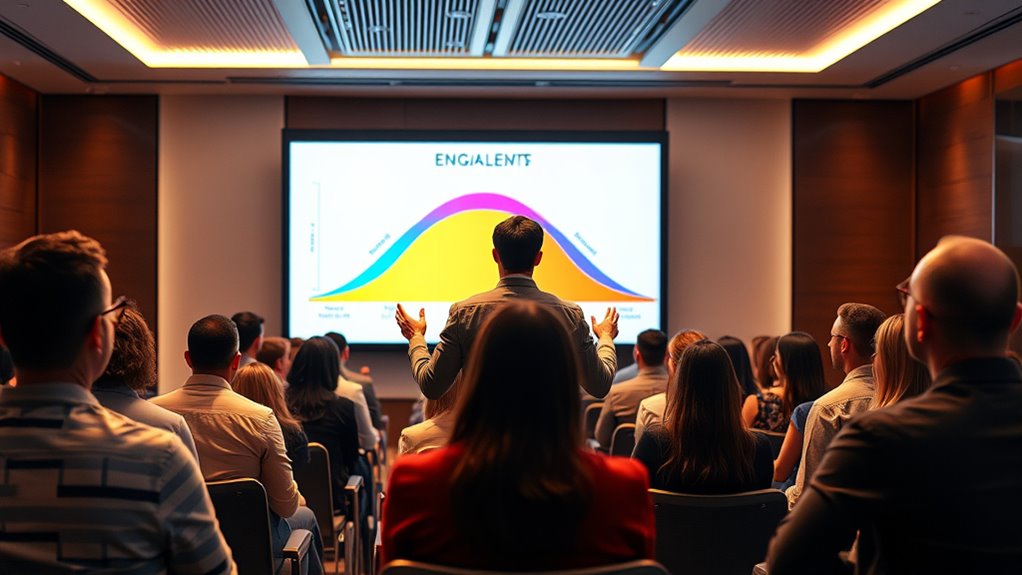
Building on the power of data to tell a compelling story, incorporating the emotional arc can elevate your presentation’s impact. When you craft an emotional resonance, you connect with your audience on a deeper level, making your message more memorable. To do this, tap into audience empathy by understanding their concerns, hopes, and motivations. Share stories or examples that evoke genuine feelings, whether it’s excitement, concern, or inspiration. By guiding your audience through a clear emotional journey—rising tension, moments of reflection, and a satisfying resolution—you keep them engaged. An effective emotional arc transforms dry data into a relatable narrative, making your message not just heard but felt, increasing its influence and staying power. Additionally, integrating relatable security system features can help illustrate the importance of safety and preparedness, further engaging your audience emotionally.
The Success Story Framework
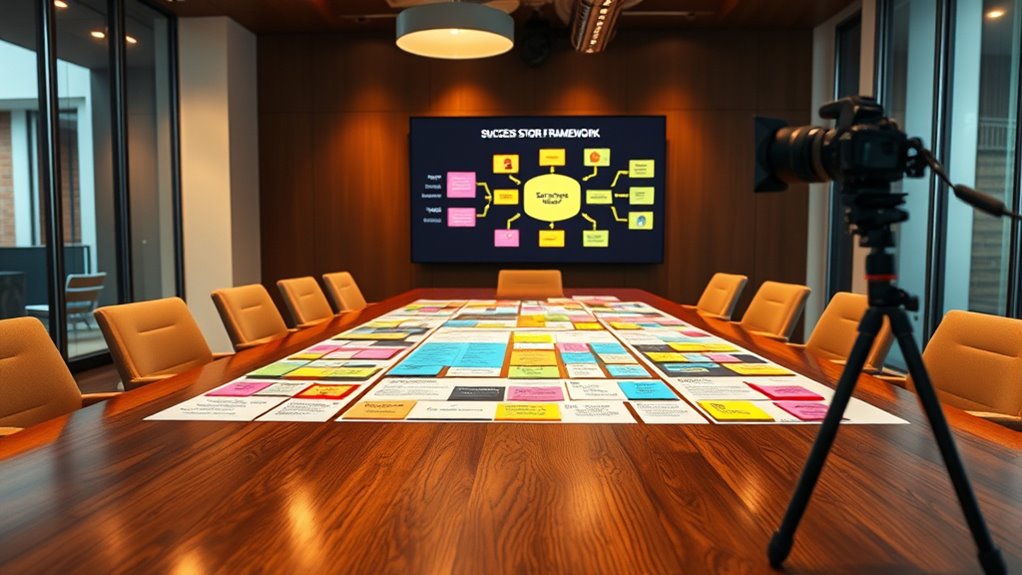
When sharing a success story, you want your audience to connect with the journey, so focus on building relatable narratives. Highlight your key achievements clearly to showcase progress, and emphasize transformation moments that marked turning points. These elements keep your story compelling and memorable.
Building Relatable Narratives
Have you ever noticed how the most memorable presentations tell a story you can see yourself in? Building relatable narratives relies on metaphorical storytelling that connects your audience’s experiences with your message. To do this effectively, consider these steps:
- Identify shared cultural relevance to make your story resonate.
- Use metaphors that mirror your audience’s daily challenges.
- Incorporate familiar scenarios that evoke empathy.
- Keep the story simple yet meaningful, ensuring it’s easy to follow.
Highlighting Key Achievements
Ever wondered how to make your achievements stand out in a presentation? The Success Story Framework helps you showcase your corporate achievements effectively. Focus on highlighting specific milestones, such as project completions or sales targets met, to create a compelling narrative. Use clear data and visuals to emphasize the impact of these achievements, making them memorable. Incorporate stories of challenges overcome or team efforts involved, tying achievements to your organization’s goals. Celebrating milestone achievements not only boosts morale but also reinforces your team’s value. Keep your message concise, emphasizing the significance of each accomplishment. By framing corporate achievements as success stories, you engage your audience and demonstrate progress, making your internal presentation impactful and memorable.
Emphasizing Transformation Moments
Building on the power of showcasing achievements, highlighting transformation moments shifts the focus from what was accomplished to how significant changes occurred. This narrative shift keeps your audience engaged by emphasizing the journey of growth. To effectively emphasize transformation moments:
- Identify key turning points that marked a change.
- Use vivid descriptions to illustrate the before-and-after states.
- Highlight challenges faced and how they were overcome.
- Connect these moments to broader goals, showing impact.
The Visual Storytelling Method

What makes a presentation memorable? It’s the power of visuals to convey your message instantly. The Visual Storytelling Method leverages color psychology to evoke emotions and reinforce your narrative. For example, blue can build trust, while red energizes your audience. Using visual metaphors transforms complex ideas into relatable images, making your message stick. Instead of overwhelming your slides with text, focus on compelling visuals that guide your audience through your story. This approach creates a clear, emotional connection, keeping your listeners engaged. By combining strategic color choices with powerful metaphors, your presentation becomes more than just information—it becomes a memorable experience. Mastering this method helps you communicate more effectively and leave a lasting impression.
Frequently Asked Questions
How Do I Choose the Right Storytelling Framework for My Internal Presentation?
When choosing the right storytelling framework, start by analyzing your audience—understand their needs, preferences, and knowledge level. This helps you select a framework that’s adaptable and engaging. Focus on storytelling adaptability; pick a structure that allows you to tailor your message effectively. Whether you need to inform, persuade, or motivate, a flexible framework guarantees your story resonates and keeps your audience engaged throughout your internal presentation.
Can These Storytelling Frameworks Be Combined for a More Compelling Narrative?
You can definitely combine storytelling frameworks to create stronger storytelling synergy and achieve better narrative integration. By blending elements from different frameworks, you tailor your message to resonate more deeply with your audience. Just guarantee the combined frameworks complement each other, avoiding confusion. When done thoughtfully, this approach enriches your internal presentation, making it more engaging and memorable for your listeners.
How Do I Adapt Storytelling Techniques for Different Company Cultures?
While it’s tempting to think one size fits all, adapting your storytelling to different company cultures is key. You should observe and understand your audience’s values and communication style first. Then, tailor your storytelling adaptation accordingly—use formal approaches for traditional cultures or more casual, engaging techniques for innovative environments. Flexibility lets you connect authentically, making your message resonate deeply within each unique company culture.
What Are Common Mistakes to Avoid When Applying These Storytelling Frameworks?
When applying storytelling frameworks, avoid overusing clichés, which can make your message feel unoriginal and lose impact. Also, don’t ignore your audience’s needs—failing to tailor your story may cause disengagement. Focus on authenticity and relevance, stay clear of predictable tropes, and guarantee your story resonates with your listeners. This keeps your presentation compelling, memorable, and aligned with your audience’s expectations.
How Can I Measure the Effectiveness of My Internal Storytelling Presentations?
To measure your internal storytelling presentation’s effectiveness, you should gather feedback through surveys or direct questions afterward. Monitor engagement metrics such as participation levels, attention span, or follow-up actions. These indicators reveal how well your story resonated and if it motivated your team. By combining feedback methods and engagement metrics, you get a clear picture of your presentation’s impact and areas for improvement.
Conclusion
Now, imagine your next internal presentation not just informing but truly enthralling. With these storytelling frameworks, you’re equipped to craft narratives that resonate, persuade, and inspire action. But the real question is—will you harness these tools to transform your stories into unforgettable experiences? The choice is yours. Step into the spotlight, and let your story unfold in a way that leaves everyone enthusiastic for what’s next. The stage is set—are you ready to take it?









